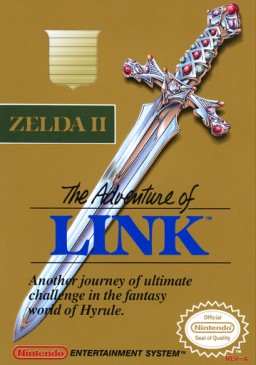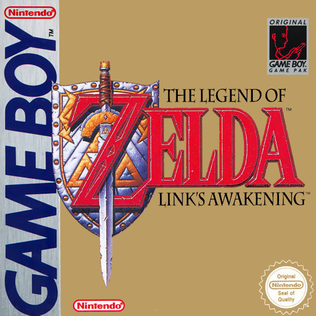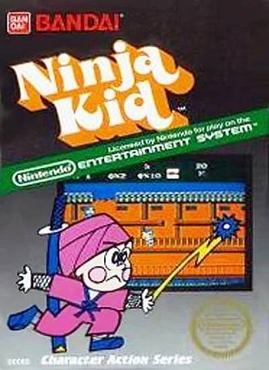
Final Fantasy Adventure, known in Japan as Seiken Densetsu: Final Fantasy Gaiden or simply Seiken Densetsu, and later released in Europe as Mystic Quest, is an action role-playing video game developed and published by Square for the Game Boy. It is a spin-off of the Final Fantasy series and the first game in the Mana series.

The Legend of Zelda: A Link to the Past is an action-adventure game developed and published by Nintendo for the Super Nintendo Entertainment System. It is the third game in The Legend of Zelda series and was released in 1991 in Japan and 1992 in North America and Europe.

Zelda II: The Adventure of Link is an action role-playing game developed and published by Nintendo. It is the second installment in the Legend of Zelda series and was released in Japan for the Famicom Disk System on January 14, 1987—less than one year after the Japanese release and seven months before the North American release of the original The Legend of Zelda. Zelda II was released in North America and the PAL region for the Nintendo Entertainment System in late 1988, almost two years after its initial release in Japan.

The Legend of Zelda: Link's Awakening is a 1993 action-adventure game developed and published by Nintendo for the Game Boy. It is the first installment in The Legend of Zelda series for a handheld game console. Link's Awakening is one of the few Zelda games not to take place in the land of Hyrule, and it does not feature Princess Zelda or the Triforce relic. Instead, the protagonist Link begins the game stranded on Koholint Island, a place guarded by a whale-like deity called the Wind Fish. Assuming the role of Link, the player fights monsters and solves puzzles while searching for eight musical instruments that will awaken the sleeping Wind Fish and allow him to escape from the island.
Dragon Quest Monsters is a spin-off series of the Dragon Quest games. Primarily developed by Tose and published by Square Enix, it sets the player in a medieval/fantasy world filled with magic, monsters and knights. Unlike the original Dragon Quest games, the player's character does not do any of the fighting in battles; instead the player has to rely on capturing, breeding and raising monsters to do the fighting for them. The concept originated from Dragon Quest V (1992). The character and monster designs are by Dragon Ball creator, Akira Toriyama. The series spans several handheld gaming systems, and each game has received positive reviews from critics. The series' gameplay has been compared to Pokémon.

Balloon Kid is a flying platform game developed and published by Nintendo for the Game Boy on October 5, 1990, in North America and on January 31, 1991, in Europe. It is the sequel to Balloon Fight. It was never released in Japan for the original Game Boy; however, two years after its original release, a licensed Family Computer port titled Hello Kitty World was reprogrammed and released by Sanrio's subsidiary Character Soft exclusively in Japan on March 27, 1992. A Game Boy Color edition with a few new features titled Balloon Fight GB was released in Japan on July 31, 2000.

Star Ocean: The Second Story, known in Japan as Star Ocean: Second Story, is an action role-playing video game developed by tri-Ace and published by Enix for the PlayStation. It is the second game in the Star Ocean series and the first game in the series to be released outside Japan, arriving in North America in June 1999 and Europe in April 2000, by Sony Computer Entertainment. Taking place in a science fantasy universe, the story centers around a young man named Claude C. Kenny, a cadet from a space-faring Earth organization who is stranded on an undeveloped, medieval-level planet. There, he meets several companions and must stop a plot from an evil organization that spans multiple worlds before finding his way home. The game was the basis of manga and anime adaptations.

Star Ocean: Blue Sphere is an action role-playing video game developed by tri-Ace and published by Enix for the Game Boy Color handheld video game console in June 2001. It is a spin-off entry in the Star Ocean series, acting as a direct sequel to the 1998 PlayStation title Star Ocean: The Second Story. It was later remade for mobile devices, releasing in 2009.
Several LCD games based on Legend of Zelda game series have been released. The first, Zelda, released in 1989, was developed and manufactured by Nintendo; later LCD games were licensed to other developers. The Legend of Zelda game watch (1989) is a wristwatch game produced by Nelsonic as part of their Nelsonic Game Watch series. Zelda no Densetsu: Kamigami no Triforce is a fighting game produced by Epoch Co. for the Barcode Battler II platform, and was released only in Japan.

Nintendo Puzzle Collection is a 2003 video game compilation published for the GameCube in Japan by Nintendo. It includes updated versions of three Nintendo-published puzzle video games released for older systems — Yoshi's Cookie (1992), Panel de Pon (1995), and Dr. Mario 64 (2001) — featuring updated graphics and music, alongside four-person multiplayer. The player can download one of the games to their Game Boy Advance via the GameCube – Game Boy Advance link cable.

Densetsu no Stafy 4 is a platform video game developed by Tose and published by Nintendo for the Nintendo DS. It is the fourth game in The Legendary Starfy series. As with the other games in the series, Densetsu no Stafy 4 features Stafy, known as Starfy in Western regions, as the main character. He is joined by his sister Starly and his friend Moe the clam. The three of them help out other undersea creatures and fights numerous villains.

The Legendary Starfy is a video game series developed by Tose and published by Nintendo. The series is the only franchise for which Tose owns the copyright, which they share with Nintendo; as a result, Tose, which normally does not put their company name on their games, does so in the Starfy series. The series began in 2002 with Densetsu no Stafy for the Game Boy Advance, and four sequels were released. For its first seven years, Starfy games were not released outside Japan. The fifth and latest game in the series was released as The Legendary Starfy in North America on June 8, 2009.

Tose Co., Ltd. is a Japanese video game development company based in Kyoto. It is mostly known for developing Nintendo's Game & Watch Gallery series, various Dragon Ball games, as well as other Nintendo products. Tose has developed or co-developed over 1,000 games since the company's inception in 1979, but is virtually never credited in the games themselves. Tose maintains a policy of having no creative input into the work they do, going so far as to refuse to put their names in the credits for most of the games they work on. As such, Tose has gained a reputation for being a "ghost developer".

Ninja Kid, known in Japan as GeGeGe no Kitaro - Yōkai Daimakyō, is an action video game developed by Tose and published by Bandai for the Nintendo Entertainment System.

Densetsu no Stafy 2 is a platform video game developed by Tose and published by Nintendo for the Game Boy Advance in Japan on September 5, 2003. It is the second game in The Legendary Starfy series.

Densetsu no Stafy 3 is a platforming video game developed by Tose and published by Nintendo for the Game Boy Advance only in Japan on August 5, 2004. It is the third game in The Legendary Starfy series, as well as the third and last title of the series developed and released for the Game Boy Advance. Later, its sequel, Densetsu no Stafy 4, was developed for the Nintendo DS.

Nintendo Software Planning & Development Division, commonly abbreviated as Nintendo SPD, was a Japanese research, planning and development division owned by Nintendo and housed inside the Nintendo Development Center in Kyoto, Japan. The division had two departments: Software Planning & Development Department, which primarily co-produced games with external developers; and Software Development & Design Department, which primarily developed experimental and system software. The division was created during a corporate restructuring in September 2003, with the abolition of the Nintendo R&D1 and Nintendo R&D2 departments.

The Legendary Starfy, known as Densetsu no Stafī: Taiketsu! Daīru Kaizokudan in Japan, is a 2008 platform video game developed by Tose and published by Nintendo for the Nintendo DS handheld video game console. It is the fifth game in The Legendary Starfy video game series. On June 8, 2009, the game became the first, and so far the only, in the series to be released outside Japan.

Shiren the Wanderer is a video game series of roguelike and role-playing games developed by Spike Chunsoft. Unlike licensed crossovers within the Mystery Dungeon franchise, this series features original characters; including the eponymous rōnin protagonist Shiren and his traveling companion and talking weasel Koppa, with a plot and the location set generally in feudal Japan, and though indicative of the core games, which is navigating through a randomly generated dungeon using turn-based moves. As of January 2024, there have been multiple games across Nintendo and Sony platforms, mobile devices, Windows, and Steam, as well as few other medias released throughout the years.

Shiren the Wanderer GB2: Magic Castle of the Desert is a roguelike role-playing video game developed by Chunsoft. It is part of the Mystery Dungeon series, and is a sequel to Shiren the Wanderer GB: Monster of Moonlight Village. It was originally released for the Game Boy Color by Chunsoft in 2001. A Nintendo DS remake was released by Sega later in 2008.


















